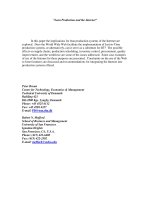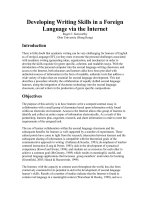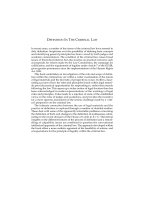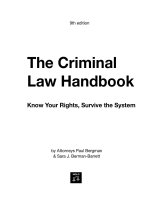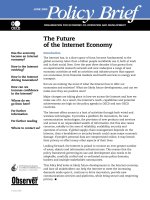investigating child exploitation and pornography the internet, law and forensic science
Bạn đang xem bản rút gọn của tài liệu. Xem và tải ngay bản đầy đủ của tài liệu tại đây (5.17 MB, 321 trang )
INVESTIGATING CHILD
EXPLOITATION AND
PORNOGRAPHY
This page intentionally left blank
INVESTIGATING CHILD
EXPLOITATION AND
PORNOGRAPHY:
THE INTERNET, THE LAW
AND FORENSIC SCIENCE
Monique Mattei Ferraro, JD, CISSP
Eoghan Casey, MS
Michael McGrath, MD, Contributor
Amsterdam • Boston • Heidelberg • London • New York • Oxford • Paris •
San Diego • San Francisco • Singapore • Sydney • Tokyo
Acquisitions Editor Mark Listewnik
Project Manager Sarah Hajduk
Associate Acquisitions Editor Jennifer Soucy
Developmental Editor Pamela Chester
Marketing Manager Christian Nolin
Cover Design Greg Smith
Interior Design Kenneth Burnley
Composition Best Set
Printer Maple-Vail
Elsevier Academic Press
200 Wheeler Road, Burlington, MA 01803, USA
525 B Street, Suite 1900, San Diego, California 92101-4495, USA
84 Theobald’s Road, London WC1X 8RR, UK
This book is printed on acid-free paper.
Copyright © 2005, Elsevier Inc. All rights reserved.
No part of this publication may be reproduced or transmitted in any form or by any means,
electronic or mechanical, including photocopying, recording, or any information storage and
retrieval system, without permission in writing from the publisher.
Permissions may be sought directly from Elsevier’s Science & Technology Rights Department in
Oxford, UK: phone: (+44) 1865 843830, fax: (+44) 1865 853333, e-mail:
You may also complete your request on-line via the Elsevier
homepage (), by selecting “Customer Support” and then “Obtaining
Permissions.”
Library of Congress Cataloging-in-Publication Data
APPLICATION SUBMITTED
British Library Cataloguing in Publication Data
A catalogue record for this book is available from the British Library
ISBN: 0-12-163105-2
For information on all Academic Press publications visit our Web site at
www.books.elsevier.com/forensics
Printed in the United States of America
05 06 07 08 8 7 6 5 4 3 2 1
M.M.F.
This work is dedicated to my husband, Albert, my daughter, Sara, my son
Nicholas and his birth mother Amy.
E.C.
To my family, particularly my wife Genevieve and mother Ita, for constantly
reminding me of the good in this world.
When will our consciences grow so tender that we will act to prevent human misery
rather than avenge it?
Eleanor Roosevelt
If we don’t stand up for children, then we don’t stand for much.
Marian Wright Edelman
About the Authors xi
Preface xiii
Acknowledgments xv
SECTION I THE INFLUENCE OF TECHNOLOGY
1. Overview 3
1.1 Background 5
1.2 History of Child Sexual Exploitation 6
1.3 Child Pornography 8
1.4 Technology and Child Exploitation 9
1.5 Technology and Preferential Sex Offenders 15
1.6 Development of Child Pornography Law 16
1.7 International: The United Nations Convention on the Rights of the Child 18
1.8 Conclusion 18
References 19
2. Internet Applications 21
2.1 IP Addresses and Domain Name System 22
2.2 E-Mail 23
2.3 E-Groups and Mailing Lists 24
2.4 List Serves 31
2.5 Newsgroups, Discussion Boards, and Bulletin Boards 31
2.6 Web Sites 33
2.7 Chat Rooms and Internet Relay Chat 35
2.8 Instant Messaging 36
2.9 Web Cameras and Videophones 37
2.10 File Transfer Protocol (FTP) 37
2.11 Peer-to-Peer (P2P) 38
2.12 Conclusion 39
Resources 39
3. Cyber Victims 41
3.1 Victimology 45
3.2 How to Protect Children Online 45
3.3 Conclusion 47
References 47
Internet Resources 49
CONTENTS
CONTENTS
4. Cyber Offenders 51
4.1 The Online Sexual Predator 53
4.2 The Child Molester 57
4.3 Modus Operandi: How Online Child Molester Operates 63
4.4 Signature and the Online Child Molester 69
4.5 Profiling the Child Molester 71
4.6 The Subculture of Child Pornography 73
4.7 Conclusion 73
References 74
5. Sources of Digital Evidence 79
5.1 Open Computer Systems 81
5.2 Embedded Computer Systems 88
5.3 Communication Systems 91
5.4 Peripheral Devices 97
References 97
SECTION II INVESTIGATING INTERNET CHILD EXPLOITATION
6. Undercover Operations 101
6.1 Self-Protection 101
6.2 Using Personal Equipment 103
6.3 Setting Up Internet and Telephone Connections 104
6.4 Using Online Undercover Identities 105
6.5 Conducting an Online Investigation 105
6.6 Documenting Predisposition of the Suspect to Commit a Crime 107
6.7 Preparing for a Meeting or Search 107
6.8 Agencies and Resources 112
6.9 Conclusion 113
References 114
Internet Resources 114
7. Collecting and Preserving Evidence on the Internet 115
7.1 Preserving Evidence on the Internet 115
7.2 Finding Evidence on the Internet 116
7.3 Collecting Remote Evidence 119
References 127
8. Tracking on the Internet 129
8.1 Attribution and Continuity of Offense 130
8.2 Tracking Internet Activities 135
8.3 Overcoming Challenges to Attribution 145
References 150
9. Search and Seizure in Cyberspace I: Drafting Warrants and Warrantless Searches 151
9.1 Search Warrant Drafting 151
9.2 Search Warrants in General 154
9.3 Child Pornography Sent via the Internet—Search Warrant for Internet
Account 156
9.4 Enticement of a Minor 158
viii
9.5 Grooming Evidence 158
9.6 The Affidavit—Probable Cause 159
9.7 Arrest Warrants 165
9.8 Warrantless Searches 166
9.9 Conclusion 170
References 170
10. Search and Seizure in Cyberspace II: Executing the Search 171
10.1 Search Warrants 171
10.2 Evidence Handling 178
10.3 Obtaining a Second Warrant 179
10.4 Executing Internet Service Provider Search Warrants 179
10.5 Conducting Preliminary Interviews 187
10.6 No Knock Warrants 188
10.7 Privileged Documents and Communications 188
10.8 The Privacy Protection Act 189
10.9 Returning Seized Items 189
References 190
SECTION III FORENSIC EXAMINATION OF DIGITAL EVIDENCE
11. Overview of the Examination Process 193
11.1 Examination 195
11.2 Analysis and Reconstruction 209
11.3 Challenges to Admissibility 213
References 215
12. Servers and Networks 217
12.1 Identification and Seizure 218
12.2 Preservation 219
12.3 Examination and Analysis 220
References 224
SECTION IV THE LAW OF INTERNET CHILD SEXUAL EXPLOITATION
13. Child Pornography 227
13.1 Evolution of Child Pornography Law Post-Ferber 235
13.2 Possessing Child Pornography Can Be Prohibited 236
13.3 The Child Pornography Protection Act and the Free Speech
Coalition Challenge 236
13.4 Morphed Images 237
13.5 Virtual Child Pornography 238
13.6 Conclusion 241
References 241
14. Pre-Trial 243
14.1 Introduction 243
14.2 Charging in Computer-Assisted Child Exploitation Cases 243
14.3 Case Law Concerning Charging Decisions 244
14.4 What Constitutes Possession? 246
CONTENTS
ix
14.5 Multiple Computer Users 247
14.6 Plea Bargaining Considerations 249
14.7 Selection of Evidence 252
14.8 How Much Is Enough? 253
14.9 Enticing a Minor to Engage in Sexual Activity 253
14.10 Presenting Evidence 255
14.11 Conclusion 255
Reference 256
15. Trial 257
15.1 Selecting the Jury 257
15.2 Young Victims/Witnesses 259
15.3 Expert Witnesses 261
15.4 Dissecting the Digital Forensics Expert’s Report 267
15.5 Defending the Charge 278
15.6 Conclusion 285
References 285
16. Final Thoughts 287
16.1 Setting Up an Online Child Exploitation Unit 287
16.2 Locating Resources for Investigators and Prosecutors 291
16.3 Looking Forward 292
Reference 293
Index 295
CONTENTS
x
MONIQUE MATTEI FERRARO, JD, CISSP
Monique Mattei Ferraro is an attorney and certified information systems secu-
rity professional who works in the Connecticut Department of Public Safety
Computer Crimes and Electronic Evidence Unit. She advises Connecticut’s
Internet Crimes Against Children Task Force and administers its legal and train-
ing components. She has worked in law enforcement since 1987. She is co-
author of Connecticut’s Law Enforcement Guidelines for Computer and Electronic
Evidence Search and Seizure, with The Honorable Judge John Blawie, JD and
Sergeant Andrew Russell, JD. She holds a Master’s Degree from Northeastern
University and a Law Degree from the University of Connecticut School of Law.
EOGHAN CASEY, MS
Eoghan Casey is currently a senior consultant and forensic examiner with Stroz
Friedberg LLC in Washington, DC. He was previously System Security Admin-
istrator for Yale University, and has received his BA in Mechanical Engineering
from the University of California, Berkeley, and a Master’s in Educational
Communication and Technology from New York University. He is a frequent
lecturer on computer security and computer crime and contributed to the
Encyclopedia of Forensic Science (Academic Press, December 2000), Criminal Pro-
filing, 2
nd
Edition by Brent Turvey (Academic Press, May 2002), and written
Digital Evidence, now in its second edition (Academic Press, March 2004) and
served as editor for the Handbook of Computer Crime Investigation (Academic
Press, October 2001).
MICHAEL McGRATH, MD
Michael McGrath, MD, is a Clinical Associate Professor, Department of Psychi-
atry, at the University of Rochester Medical Center in Rochester, NY. He is
ABOUT THE AUTHORS
also Associate Chair for Ambulatory Services, Department of Psychiatry and
Behavioral Health, at Unity Health System, in Rochester, NY.
Dr. McGrath divides his time between clinical, administrative, teaching, and
research activities. His areas of special expertise include forensic psychiatry and
criminal profiling. He has lectured on three continents and is a founding
member of the Academy of Behavioral Profiling.
ABOUT THE AUTHORS
xii
This work is the culmination of many years of study and work. During my under-
graduate and graduate work, my primary research interests revolved around
domestic violence, sexual assault, child abuse, and child exploitation. Femi-
nism, the Constitution, freedom of expression and privacy, politics, and the
dynamics of power are topics that seem to me to be intertwined with crime
against women and children. As time marches on, I notice that more than
twenty years have passed since I first began to study these issues. The issues have
changed a bit, but they are just as interesting, just as in need of study, and just
as intertwined as ever.
When the Internet was invented, a revolution began in the way we live our
lives. A thousand years from now, the early days of the “Internet Age” will no
doubt be considered of more historic magnitude than the Industrial Revolu-
tion or the Iron Age. In a matter of fifteen years or so, the Internet has irre-
versibly impacted every major human endeavor. The Internet has changed the
way we communicate, the way we are educated, our economy, our sexuality, our
politics and the way crime is committed. This book addresses the narrow area
of investigating the online exploitation of children.
Those whose proclivities lead them to prey on children have unprecedented
access to potential victims via the Internet. This book explores how the Inter-
net has created an unlimited and barely regulated trade in child pornography
and has opened the floodgates to the free exchange among child molesters.
Sex offenders who prefer to have sex with children have nearly unlimited access
to children when they use the Internet. Not only do sex offenders have
free access to children and to child pornography through the Internet, but they
also have the comfort and support of countless like-minded others just a
mouse-click away.
When criminal activity was constrained by limits on transportation and tech-
nology, law enforcement could confine itself to patrolling neighborhoods and
playgrounds to protect children from those who would exploit or harm them.
The Internet presents new and difficult challenges. This book aims to arm law
PREFACE
xiv
enforcement officers, prosecutors, forensic scientists, students, and academics
with awareness of emerging issues and tools.
If crime is on the streets, law enforcement personnel need to know the
language of the streets. Crime on the information superhighway is no differ-
ent. Police, prosecutors, the defense bar, and judiciary need to familiarize them-
selves with the vernacular of the Internet and high technology.
PREFACE
Monique Mattei Ferraro
I would like to thank my co-author, Eoghan Casey, who has been an excellent
friend, colleague and co-author. I thank him for his guidance and support. One
rarely finds friends who bring so much to the table. Whatever I do with him I
find is better than anything I’ve done on my own.
Thanks to Andrew Russell for believing in me. His patience and friendship
have seen me through years of exploration and growth. Joe Sudol has been very
supportive of me and of my work on this book and other far-flung projects. My
colleagues at the Computer Crimes and Electronic Evidence Unit have sup-
ported me and provided assistance in so many areas, it would be impossible to
list. In particular, I want to thank Bruce Patterson for his forensic reports,
research on experts, and for his support. Jim Smith is always there for me.
Thanks, Jim, for lending expertise, search warrant language, and dedication to
the cause. Ruth Torres has read many drafts and given her thoughtful com-
mentary, suggestions, and abiding friendship. Dan Tramontozzi, Jeff McGurk,
Steve DiPietro, John Farnham, Nick Juliano, Henry Doddenhoff, Brian
Beshara, Nick Juliano, Ivan Torres, Christina Ferrante, and Brian Blakeman
have all been unwavering in their support and making work a great place to
be. Thanks especially to Jane Schneider for all of her assistance and support
throughout.
My interns toiled endlessly for no pay and little else. Thanks to Rochelle
Fleischman, Keely Stockman, Amie Danielson, Samir Termanini, A.J. Walmbolt,
Steve Arcuri, Sarah Esidore, Alix Rosenberg, Ashlee Kelly, and Paul Battiste.
Thanks to my teachers and mentors. Special thanks to my professor, then
boss and friend, John Bardelli, who taught me everything I know.
Thank you to the many excellent colleagues and friends who read drafts and
offered salient commentary. Thanks especially to Jackie Sanford, Judith Rossi,
and John Blawie.
Special thanks to our editor, Mark Listewnik, developmental editor, Pam
Chester, associate acquisitions editor, Jennifer Soucy, and Project Manager,
Sarah Hajduk, who have been helpful, supportive, and most of all, patient.
ACKNOWLEDGMENTS
xvi
Finally, I could not do anything without the love and support of my family
and many dear friends. My friends and family helped me with the important
stuff—picking up my daughter from school, filling in for me when I couldn’t
be there, letting me sleep late when I had to. Thanks especially to my friend,
Karen, my loving husband Albert, whom I adore and my daughter, Sara, and
son, Nicholas.
Eoghan Casey
I would like to express my deepest gratitude to Monique Mattei Ferraro for her
guidance as we navigated this complex topic and for being the model of balance
between life and work. I have always been impressed by her intelligence, quality
of character, and sense of humor but never more so than during this joint
endeavor. Her enthusiasm and vision challenged me to consider many aspects
of our work in a new light, leading to a greater clarity in my understanding that
I feel is reflected in this book.
I am also delighted to have this opportunity to formally recognize Mike
McGrath’s contributions to this work and to my development over the years.
Thank you for your sage instruction and for your extraordinary friendship and
wit.
Thanks to my friends and colleagues who have continually supported me
personally and professionally. Thanks also to Mark Listewnik and the others at
Academic Press for your patience and encouragement. Without all of your help,
this book would not have been possible.
ACKNOWLEDGMENTS
SECTION I
THE INFLUENCE OF TECHNOLOGY
This page intentionally left blank
OVERVIEW
CHAPTER 1
I was born into an insane family where my grandfather physically and sexually abused me
from a young age until I was fifteen. Part of what he did was send me to strangers’ homes for
child prostitution where I was also used for child pornography. My grandfather would take
pictures of me, as well as show me haunting pictures of other kids who looked drugged and
dazed.
Growing up and trying to fit into a normal life after so much abuse is hard. I have
nightmares, flashbacks and struggle with everyday tasks that most people take for granted. . . .
There is a haunting that surrounds me constantly, reminding me that I don’t have control
over keeping my past a secret. The pictures that were taken when I was so young are still out
there. Who knows where they are and how many people have seen them. I wonder if they will
show up when I least expect it. I am away from abuse now, but know that someone could be
pleasuring himself while looking at my pictures or showing them to kids. (childlustrecovery.org
2003)
Child sexual assault and exploitation were once limited to physical locations
such as school playgrounds, church vestibules, trusted neighbors’ homes,
camping trips, and seedy, darkly lit back rooms of adult bookstores. Rapid
increases in Internet usage have created a virtual hunting ground for those who
prey on children and have fueled a brisk, multi-billion dollar trade in the asso-
ciated illicit material. Online child exploitation includes all forms of sex abuse
of children with an online nexus, particularly enticement of minors to engage
in sexual activity; manufacture, distribution, and importation of child por-
nography; and child sex tourism.
Sexual predators who travel to meet victims that they have acquired online
are sometimes called travelers.
In addition to providing a new venue for child exploitation, the Internet
reduces disincentives by providing anonymity and facilitating fantasy develop-
ment. The Internet gives offenders easier access to support groups of like-
minded individuals, reducing their sense of being marginalized (Taylor and
Quayle 2003). The Internet is also very easy to use, making it readily accessible
to even the least technologically literate among the population.
The impact of these peer support groups can be profound, “normalizing” abnormal
desires, enabling offenders to view their behavior as socially acceptable and possibly
lowering their inhibitions to act on impulses that would otherwise remain fantasy.
Additionally, these types of support groups can give offenders access to child
pornography, children and technical knowledge that would otherwise be beyond
their reach. (Casey, Ferraro, and McGrath 2004)
While the Internet has made the world smaller by bringing distant people
and places within easy reach, computer storage media have grown larger to
hold almost unfathomable amounts of information. Computer storage capac-
ity has increased to the point at which a small personal computer hard drive
can hold as much information as the United States Library of Congress. Child
pornographers use this space to store personal libraries of tens of thousands of
digital images. Additionally, people increasingly conduct their communications
and store more records electronically—financial, personal, and otherwise.
Many people view their communications, online activities, and the informa-
tion stored on their computers as private. Few people anticipate that law
enforcement will ever discover their computer’s contents—actually, few people
realize the volume of information retained by their computer about their activ-
ities. To take advantage of the large amounts of data stored and transmitted
using computers, investigators and lawyers must be cognizant of the way infor-
mation is processed and stored by computers. We talk about “digital forensics”
throughout the book. The term refers to the study of the technology, the way
criminals use it, and the way to extract and examine digital evidence. Criminals
are becoming aware of the risks and are taking steps to conceal their online
activities. In response, digital investigators are developing methods and tools to
see through such concealment behavior. This ongoing battle of wits, combined
with rapid developments in technology, makes this a challenging and dynamic
area requiring intelligent and dedicated investigators and attorneys.
Approximately half of the caseload in computer crime units involves the
computer-assisted sexual exploitation of children. Despite the scale of this
problem, or perhaps because of it, no published resources bring together the
complex mingling of disciplines and expertise required to put together a
computer-assisted child exploitation case. This work fills this void, providing
INVESTIGATING CHILD EXPLOITATION AND PORNOGRAPHY
4
police, prosecutors, and forensic examiners with the historical, legal, technical,
and social background for the laws prohibiting child exploitation—in particu-
lar, child pornography—and enticing minors to engage in sexual activity using
the Internet. In addition to providing guidance on the technical and legal
aspects of child exploitation investigations, cases and associated data are pre-
sented to provide a deeper understanding of the crimes, victims, as well as
offenders and the level of danger they pose to themselves, their victims, and
investigating officers.
1.1) BACKGROUND
Children, by definition, are not capable of making the decision to have a con-
sensual sexual relationship. Because of their tender years, lack of education and
transportation, children are completely dependent on the adults responsible
for their care. When a child is enticed into sexual activity, s/he is manipulated
into the act—not a full participant. It simply is not possible for a child who is
not granted full adult rights—to vote, to self-determination and self-support—
to consent to sex with an adult. The law has sometimes referred to sexual activ-
ity between an adult and a person not yet of adult age as “statutory rape”
because the sex was “consensual” but illegal by statute based on the difference
in age between the partners. When the child is younger, the act has often been
classified as “molestation,” a watered-down, euphemistic term for the child’s
victimization. The authors consider sex between a minor (as defined by the
jurisdiction) and an adult to be sexual assault. Sexual assault of a child can
include kissing, fondling, oral contact to genitals, and penetration whether
with an object or a part of the body.
Child pornography is a permanent record of a child’s sexual assault that
exploits the victim each time it is viewed for pleasure. It is impossible to gauge
the damage that such an assault can have on a victim, family, and community.
OVERVIEW
5
The case of Marc Dutroux shook Europe in the late 1980s. He was married
and the father of three children. He owned several houses. A large source
of his income was from the sale of young girls he kidnapped and sexually
assaulted into prostitution and creating child pornography.
Dutroux was convicted of the rape and abuse of five girls and was sen-
tenced to thirteen years in prison. He served only three years. Not long after
his release, young girls began to disappear near his several houses. Police
searched his houses, only to find nothing. Unfortunately, the police failed
to search the basement of one of the houses where two teenaged girls were
still alive—hidden and hoping to be saved.
CASE
EXAMPLE
Offenders who intentionally seek out children and take advantage of their
weaknesses for sexual purposes are a form of sexual predator. The weakness
can be emotional, psychological, or physical—or any combination of these.
There may seem to be some lack of clarity inherent in such a definition, as it
would seem that a sex offender by definition is taking advantage of or exploit-
ing the victim. Inherent in the description, though, is the expectation that the
predator has, on some level, planned the offense.
INVESTIGATING CHILD EXPLOITATION AND PORNOGRAPHY
6
In 1996, police again searched one of Dutroux’s houses where they found
a soundproof concrete dungeon in the basement. Two girls, a fourteen-year-
old and a twelve-year-old, were found in the dungeon. They were alive, but
Dutroux sexually assaulted them and filmed the assaults. Police also found
at least 300 child pornography images. Investigation revealed that Dutroux
killed at least four girls and sexually assaulted many more. His final capture
and conviction inspired public outrage that he had served only three of
thirteen years for his initial crimes. The public demanded reform of the
laws, the way the laws were enforced, and the punishments given to those
preying on their children. (Bell 2003)
A sexual predator is defined by the authors as a sex offender who takes
advantage of a weakness (or weaknesses) of a victim to further sexual
exploitation of the victim, with at least some element of planning involved.
This chapter presents an overview of online child exploitation, examining the
scope of the problem and providing a foundation for the rest of the book. The
history of child exploitation and the way technology is used to facilitate it are
explored. A section on how child protection laws developed in the United States
and abroad is followed by a brief summary of the book’s structure and contents.
The online child exploitation discussed in this book has two faces: child
pornography, together with all of the activities necessary to perpetuate it
(manufacture, distribution, importation, and possession), and the enticement
of a minor to engage in sexual activity using an online facility. Sometimes the
two crimes will be treated separately and sometimes together. Since the histor-
ical roots of the crimes are found in the sexual assault of children, we begin
discussing the crimes together.
1.2) HISTORY OF CHILD SEXUAL EXPLOITATION
The history of childhood has been a nightmare from which we have only recently
begun to awaken. The further back in history one goes—and the further away from
the West one gets—the more massive the neglect and cruelty one finds and the more
likely children are to have been killed, rejected, beaten, terrorized and sexually
abused by their caretakers. (deMause 1998)
Psychohistorian Lloyd deMause has written extensively on the global history
of child abuse. In The History of Childhood, he details the experiences of
children in India and China as particularly abusive. In India, children were
regularly masturbated by their mothers, and adults used children sexually
long before they reached the age of ten. Growing up in China was equally
cruel. Both male and female children were sexually assaulted and forced into
prostitution. Ancient Greek and Roman girls were often raped, and older men
used boys for sex. Until recently, in Western countries children were consid-
ered small adults. Labor laws and child abuse protection laws are phenomena
of the twentieth century in the United States.
Child exploitation existed long before the Internet, and networks of offend-
ers communicated before the personal computer was part of our everyday lives.
The North American Man-Boy Love Association is an example. The association
publishes its beliefs and attempts to advance the social acceptability of roman-
tic relationships between men and boys. Prior to the accessibility and instant
communication afforded by the Internet, it took more effort to find and enter
a child exploitation network. The following testimony of Joseph Henry is
illustrative:
During this time, 1975 and 1976, I was actively involved in the San Diego-based
pedophilia organization, the Childhood Sensuality Circle (CSC). I corresponded
with Valida Davila, the head of the CSC, and did some typing for her. As was the
practice with the CSC, Davila also put me in touch with other pedophiles. I can’t
stress enough that this group and others, regardless of their publicly stated goals, are
in practice little more than contact services for pedophiles. These groups serve as a
reinforcement for pedophiles and a constant source for new friendships and, thus, a
supply of new victims.
By November 1976, I was back in New York when I received a phone call from
a man named Eric Cross. Cross was a friend of John Duncan, and he said he
understood I was looking for a woman with small children who would agree to marry
me so that I could be a father and feel like an adult, not just to molest children.
At that time, I had no idea who Cross was, but I later learned he was a child
pornographer, publisher of Lolitots magazine and a pedophile with connections not
only through the United States, but in several foreign countries as well. I understand
he is now in Florida State Prison and facing a Federal trial on charges of distribution
of child pornography.
I went to Los Angeles in the fall of 1977 to meet with Cross. For several nights, I
met with Cross to look at child porn photos he was sending out of the country. Cross
OVERVIEW
7
and I were at the motel examining photos of naked children that he was sending to
a source in Canada. As we left the hotel one night, we were arrested. The police had
to release me through lack of evidence, and I was able to return to New York, but
some weeks later, I was rearrested in New York by U.S. Customs agents.
After my arrest, I learned that numerous other men had come to Los Angeles and
San Diego from 1974 to 1976 to molest children John Duncan made available to us.
Various motels and homes of two men were used as locations for the molestation.
The children were also photographed during sessions with the men.
Although I did not participate in this, one of the men, I can’t be sure which,
apparently sold photos to the Dutch child porn magazine Lolita because in the Lolita
issues 29, 30, and 31, there were shots of Tammy and Yvonne in various explicit
poses. (U.S. Senate 99
th
Congress)
The growing use of the Internet by adolescents and younger children created
the possibility for their victimization by adult sex offenders. As more and more
children flocked to the Internet in the 1990s, adults wishing to lure them into
sexual relationships welcomed them. What happened before the wide use of
the Internet? If an adult had an interest in having sex with a child, the indi-
vidual would seek contact by gaining employment where there would be expo-
sure to children, or volunteering to work with children, or having one’s own
children, or befriending the neighborhood children.
Imagine the vast difference in communications technology that has occurred
over the past quarter of a century. Anytime prior to 1995, a person seeking sex
with a child would become a scout leader, priest, teacher, clown, father, uncle,
bus driver. He might join a pedophile network like the CSC described by Joseph
Henry. A last resort would be lurking around the neighborhood playground.
In the 1980s in some places, citizens band radio was popular among preteens
and teenagers, and adults would meet children through that medium. Mostly,
though, until the increased use of the Internet, adults met child-victims through
the adults’ employment or familial ties.
1.3) CHILD PORNOGRAPHY
The term “pornography” was first defined in the Oxford English Dictionary
in 1857 and was referenced earlier in French writing to refer to writing about
prostitution, obscenity, and obscene images (Hunt 1993). Each jurisdiction has
its own, very specific, definitions of “child” and “pornography.” For our pur-
poses in this brief introduction to the matter, “child pornography” can be func-
tionally defined as an image that depicts a clearly prepubescent human being
in a sexually explicit manner.
1
There will be no pictures depicting child por-
nography. Whenever necessary, such as in the discussion about virtual child
INVESTIGATING CHILD EXPLOITATION AND PORNOGRAPHY
8

